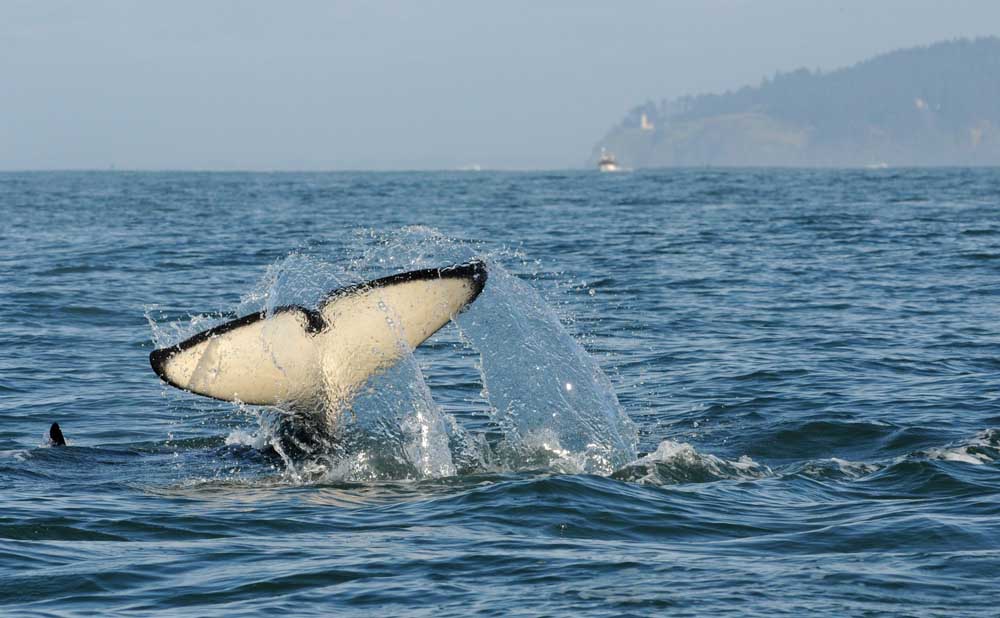Orca pod struggles to thrive
Published 4:07 am Monday, March 23, 2015

- This orca was photographed near the mouth of the Columbia River in 2015 by researchers from the National Oceanic and Atmospheric Administration. North Head Lighthouse and Lewis and Clark Interpretive Center can be seen in the background. A new study says that the small population of endangered Puget Sound orcas are having pregnancy problems due to stress from not getting enough salmon to eat.
PACIFIC OCEAN — The only killer whales most Long Beach (Wash.) Peninsula residents see in person are the chainsaw carvings displayed in a small square on the corner of Pacific Avenue and Fifth Street, where Long Beach’s famous giant skillet also resides.
Trending
But satellite tracking now shows that orcas make an extensive hunting trip along the outer coast every year.
Orcas have probably been coming here a long time. Fishing boats sometimes report seeing them in the Columbia River plume, the nutritionally rich area where the river’s outflow mixes with the ocean. Retired charter boat skipper Ron Malast recalled encountering a pod of orcas in May or June about six years ago as he was returning to Ilwaco, Wash., from a halibut fishing trip.
Some have even claimed to see them inside the Columbia estuary. In the 1930s, a young killer whale journeyed more than 100 miles up the Columbia River, delighting Portlanders for two weeks with its antics before coming to a tragic end at the hands of ex-whalers. This winter, they have been observed foraging in relatively shallow waters near the mouth of Willapa Bay.
Trending
Despite many sightings of the whales over the years and survey cruises by NOAA since the early 2000s, these particular killer whales — part of an endangered population consisting of several pods (or families) called the Southern Resident Killer Whales — remain something of a mystery. Researchers still struggle to answer seemingly basic questions about their daily habits and longterm needs.
And there are very big worries about their continued survival.
“What does ‘sort of normal’ look like?” asked Dr. Brad Hanson, a wildlife biologist with NOAA’s Northwest Fisheries Science Center and chief scientist for the most recent NOAA killer whale cruise, in a phone interview March 6. His team followed the whales along the Northwest coast for three weeks beginning in February.
Researchers look to the Northern Resident Killer Whale pods that live off the coast of British Columbia, Canada, for clues, he said. Unlike the southern population, that population is clearly growing and there is a good balance of reproductive-age male and female whales.
Meanwhile, the southern whale pods “are about where they started at” when NOAA began studying them and “there’s a very skewed sex class,” Hanson said. Also, whales biologists don’t expect to lose are dying: young, seemingly healthy, breeding-age whales.
In December 2014, a young female orca from the J Pod — one of the three pods (J, K, and L) that make up the southern resident population — was found dead near Vancouver Island. She was pregnant. Her dead calf was also female.
“That was a double whammy,” Hanson said.
The pregnancy was likely a miscarriage and Hanson said initial investigations indicate the mother may have died from a related infection.
“You look back 40 years and we had fewer reproductive-age females than we do now and the population managed to grow from 74 to 80,” Hanson said. Now, there are 77 whales, but of those 30 are female and few are producing calves. It is possible they are having calves, but those calves are dying before biologists ever lay eyes on them.
L pod is especially worrisome. Along with K pod, L pod is the group that so far appears to spend the most time on the outer coast. According to NOAA studies, at the end of 2010, L pod had few young whales and many mature whales reaching the end of their breeding years.
Ken Balcomb, a senior research scientist at the Center for Whale Research on San Juan Island,, Wash., takes it another step further. L pod is on its way to extinction, he wrote in a public comment against a proposed renewal of a permit that would allow the Navy to test sonar in whale and salmon habitat.
In written remarks submitted Feb. 28 in support of expanding the area of critical habitat for souther resident orcas, Balcomb said, “Overall, the population is now worse off than it was when it was first designated Endangered in November 2005, in spite of $15.6 million spent on recovery efforts. L pod, read most coastal in this habitat, is well on its way to extinction with only two viable matrilines remaining of ten that were present when we began our demographic studies of this population in 1976.”
Still, there is a spot of hope: Hanson and his team spotted a calf, L121, only several days old, swimming with L Pod directly off the Long Beach Peninsula Feb. 26 during the survey cruise.
The Navy is seeking to reauthorize five-year testing permits to continue testing and training in the Olympic National Marine Sanctuary. NOAA will need to sign off on these applications since the testing will likely result in “incidental take,” or the “unintentional harm or harassment of an endangered species as long as it affects a small portion, has no more than a negligible effect, and does not have an unmitigable effect,” according to NOAA spokesperson Michael Milstein.
But advocates and environmental groups say the Navy’s plans could decimate marine mammal and fish populations.
At a press conference March 5, Lynne Barre, NOAA’s west coast branch chief said, the agency is in the process of reviewing information about the Southern Resident Killer Whales’ use of coastal habitat and considering a petition to expand critical habitat areas — including potentially 700 miles of coastline and areas where the Navy is hoping to test.
This would give the whales an extra layer of protection.
Much of the data gathered on this year’s whale survey cruise will inform that process, she said.
The 2013 and 2015 cruises are the most productive to date, Hanson said. But while they gathered a wealth of information on the whales’ winter habits and enjoyed many successful days of observation both years, it’s not enough to see patterns emerge.
For example, he and others believe the southern population’s low birthrate could be due to contaminants in the water such as PCBs. They know the whales are experiencing higher levels of contamination in their bodies than before. Part of the problem is they don’t have anything to compare the current levels to. They don’t know exactly what the contaminant levels looked like in prior decades.
The whales shed these contaminants at a relatively low rate, Hanson says, and a female will transfer much of them to her calf. High contaminant levels could mean a higher susceptibility to disease, among other things.
Balcomb told ocean conservation group BlueVoice that he saw “pretty serious mortality” beginning in the mid-90s. He looked at video footage from the 1980s and 90s and said, “Just in a period of less than 20 years we’ve lost most of the adult males in the whole southern resident community” — something he attributed to high PCB levels in the whales’ tissues.
“Their immune systems are depressed, much like AIDS,” he told BlueVoice co-founder Hardy Jones.
But, Hanson said, transient killer whales — ones that range around the North Pacific Ocean and go after marine mammals, unlike the southern and northern residents, which eat fish — are loaded with contaminants.
“They make the southern residents look clean,” he said. “And that population is growing quite well.”
“I ask that question all the time: Explain why this happens,” he added. “…There’s no pattern to it. That’s the problem.”









